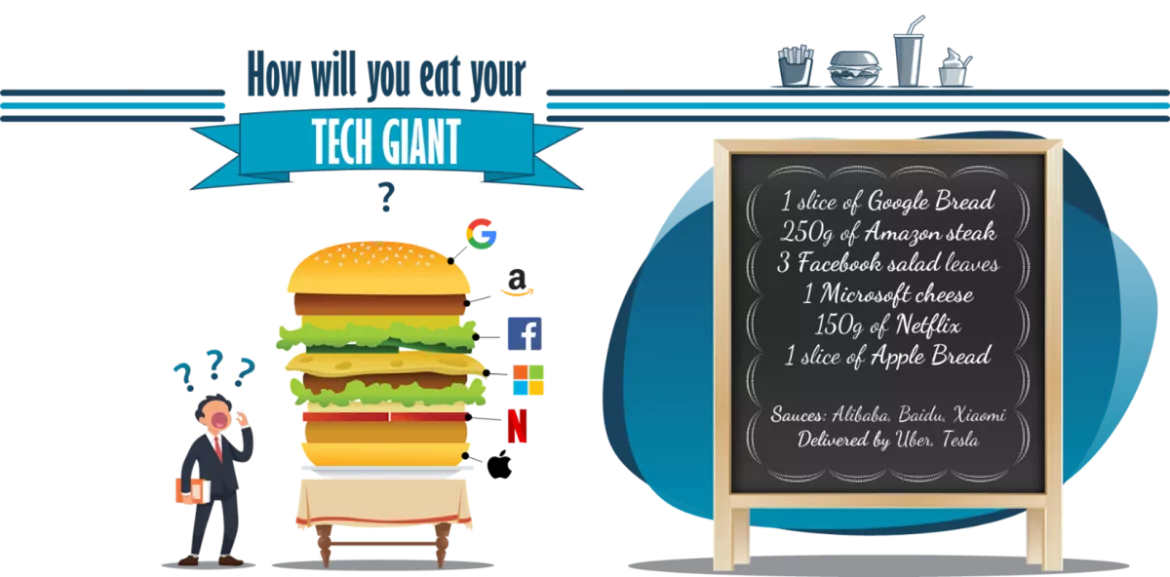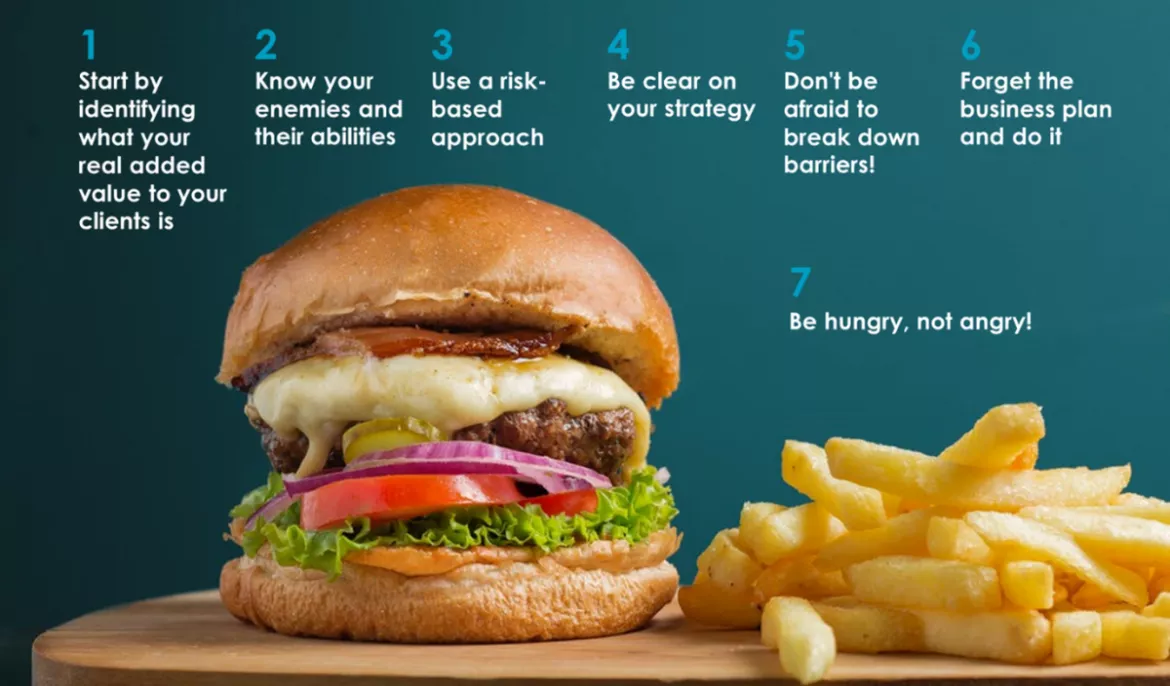How will you eat your Tech Giant?
Who could have imagined that a burger could represent recent development in the big tech economy? When restaurants remain closed, fast food and delivery solutions at your fingertips have taken over. In today’s menu: GAFAMBATXNATU. No, it is not an exotic food specialty . This simple word can be valued up to tens of Trillion euros. You probably saw it in different forms, sometimes GAFAM, BATX, or NATU. Those acronyms are, of course, referring to the tech giants: #Google #Amazon #Facebook #Apple #Microsoft #Baidu #Alibaba #Tencent #Xiaomi #Netflix #Airbnb #Tesla #Uber. These companies have enormous economic power and are dominating the tech industry.

Tech Giants: The Fast Economy?
Some consider them aliens coming from another planet because of their superior data intelligence and their seamless capacity to disrupt the traditional world. Tech Giants are not regular companies. They are creating a new world. They sit on mountains of data which allow them to continuously reinvent themselves, adapt their offerings in real-time to achieve their target and transform much-desired gadgets into must-haves. This positions them often 5 steps ahead of their competitors. The limits of their capabilities seem hard to understand, and their real agenda out of reach.
Others believe that Tech Giants are modern geniuses who are reshaping the world at an incredible pace. Like Leonardo Da Vinci being an inventor, philosopher, mathematician, writer, and physician, these Tech Giants are driven to change all aspects of our world and do everything better. They influence the way we move, how we get information, how we pay, the way we interact, or the way our food is delivered. They generate new markets, change rules, and influence human behaviours. Sometimes they go too far, breaking the rules, laws and testing things illegally.
Although Market Capitalisation is not an entirely trustful indicator, it reflects how fast these digital superstars are growing. Apple, Amazon, and others like Google are often compared to the GDP of European countries like Spain, the Netherlands, or Switzerland. This is impressive, yet, we forget that the majority of these companies did not exist 20 years ago. Companies like Exxon, General Electric, Shell, Coca-Cola, Merck, or Walmart have been completely erased from the list of the largest companies to leave room for utterly new market players: the digital companies.
Tech Giants: consider them in your business plan
Whether you are a citizen, a company, or a government body, there is always a fast food Tech Giant around the corner.
Industries such as Banking, Transport, Healthcare, or Energy are well known to Avertim, and they are all impacted by Tech Giants. Our clients have been watching the steady growth of this competition, sometimes shaking up established business models. Even when we do not expect it, Tech Giants can surprise by their appetite for acquisitions and new market entries. For example, the acquisition of LinkedIn by Microsoft for $26,2 billion shows their financial capacity. Everyone would agree that these companies have a clear strategy of omnipresence and are disrupting any industry or sector they enter. They are able and willing to spend an enormous amount of cash to shape the future while continuously putting user-friendliness at the centre. In doing so, Tech Giants push more traditional companies to be more reactive and more agile to change their strategy profoundly. They changed the fundamental rules of business strategy by tormenting traditional markets and competition. The internet has become a commodity, and artificial intelligence (AI) and hyper-personalization, are the norm; making them strong.
The future is in connected objects. Products are already being developed to be deployed in networks, homes and cars, buildings and factories, cities, and regions. At the end of April 2021, Amazon announced that they are opening a hair salon in London. Who could have predicted this? This might be a marketing stunt or perhaps it offers them a way to test AI rather than aiming to become the #1 hairdresser. It proves that Amazon, as do others, explores the market to increase its share and impact. If you do not consider yourself to be concerned, maybe you are the alien (or the next KODAK)?
Want to know more about the impact of Tech Giants in your industry?
Our 7 tips for a successful strategy

#1 Start by identifying what your real added value to your customers is. Customer-centricity is where Tech Giants are the best. Being driven by customers’ needs is the first step to remain competitive and future-proof; this is the starting point for your strategy. It will also make the introspective exercise towards strengths and weaknesses much easier.
#2 Know your enemies and their abilities. Newton’s Second Law of Physics says Force = Mass x Acceleration. Tech Giants have tons of information and are constantly moving. This is what makes them unpredictable. If you do not follow their every move (product launch, investments, acquisitions, collaboration within your industry and competitors), you will not be aware of their real “Force”. It is a second way of evaluating your strengths and weaknesses against the capabilities of your competitor Tech Giant(s). Our advice, do not skimp on a dedicated unit for Market Intelligence doing regular updates to the top management.
#3 Use a risk-based approach. Such a decision will drive the future of your company and impact your entire organisation and should, of course, not be taken lightly. However, standard risk management methodologies might not be the best tool to perform this exercise. Take the time to select the right risk management framework or even design one yourself (finding the right balance between a botched and a never-ending exercise with tens of scenarios). In the end, the business benefits and the risks associated with each scenario should be clear and understood by everyone, starting with the Top Management. Use simple “what if” questions to challenge your strategy (eg what if my main competitor is partnering with or acquired by a tech company? What if a Tech Giant launching a product or service cannibalises my cash cow product/service? What if my competitors merge and become the #1 player in the marketplace?).
#4 Be clear on your strategy. There is no in-between collaboration and fight. It can be compared to geopolitical wars. You must position yourself even if it might close some doors. So, take a decision and stick to it. If you decide to collaborate, then clearly define the red lines and the scope of the collaboration. As an example, exclusivity is often a very good way to protect yourself (particularly with Tech Giants having a business model driven by platformisation).
#5 Do not be afraid to break down barriers! Both the speed and disruptive nature of the change will fundamentally transform your value chains and shake up your business model. Even if strategy becomes more short term, one should still look at a 5 or 10 year plan which, above all, includes your customers in the innovation process. Tech Giants’ business model antinomy (for example Apple adopting premium pricing vs. Google proposing Freemium services) indicates that all options are on the table.
#6 Forget the business plan and just do it. History has shown that disruptive innovation rarely operates to a business plan and data in itself has no ROI. Long term strategy doesn’t necessarily mean rigid and long studies. A capability to test, a healthy appetite for risk and acceptance to fail should be embedded in the culture and process of the organisation. To do so, organisations should bet on agility and remove internal barriers.
#7 Be hungry, not angry!
Written by

- Maxime P., Director of the Solution Department
If you have read this article, you might be interested in:
Our Whitepaper: digital solutions across the pharma value chain
How to make your MedTech startup attractive for international corporate leaders?
